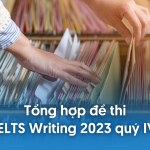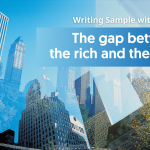THE GAP BETWEEN THE RICH AND THE POOR – KHOẢNG CÁCH GIÀU NGHÈO

There is a prevailing belief that the disparity between the affluent and the impoverished is expanding. This escalating gap gives rise to multifaceted challenges that can significantly impact society. However, various measures can be implemented to mitigate these issues.
| prevail (v) chiếm ưu thế, thịnh hành, áp đảo
disparity (n) sự cách biệt, chênh lệch (~difference) affluent (adj) giàu có (~rich) impoverished (adj) nghèo khó, bần cùng (~poor) escalate (v) leo thang, phát triển multifaceted (adj) có nhiều mặt, khía cạnh implement (v) tiến hành, thực hiện mitigate (v) giảm nhẹ, giảm thiểu |
The widening gap between the rich and the poor can lead to plenty of difficulties in various aspects of society. One of the most significant predicaments resulting from this is the exacerbation of social inequality. This is due to the fact that the wealthy are normally more respected and have a higher status while the less privileged members of society may be perceived as less important and unfairly treated, which can further lead to increased social tension. In addition, economic downturn can be inevitable as the uneven distribution of wealth can hinder sustainable development. When a small segment of society possesses a disproportionately large share of the resources, it can impede economic growth and dampen consumer spending. Consequently, it may result in multiple challenges for a nation’s economy such as reducing demand for goods and services, adversely affecting businesses, employment rates, and overall economic stability.
| predicament (n) khó khăn (~disadvantage)
exacerbation (n) sự trầm trọng hóa privileged (adj) có đặc quyền, được ưu tiên social tension (n phr) sự căng thẳng/mâu thuẫn xã hội economic downturn (n phr) sự suy thoái kinh tế inevitable (adj) không thể tránh khỏi hinder (v) cản trở disproportionate (adj) không cân xứng, mất cân đối impede (v) cản trở (~hinder) dampen (v) hạn chế, cản trở (~hinder, impede) adversely (adv) một cách bất lợi |
To address this issue, a multi-directional approach is necessary. Firstly, governments can implement progressive tax policies to ensure that the rich contribute more proportionately to the welfare of the entire society. Redistributive measures such as targeted social welfare programs and educational initiatives can also play a crucial role in narrowing the gap. By providing the less privileged with access to quality education, job training, and healthcare, governments can help bridge the status division and promote upward social mobility. Furthermore, fostering an economically friendly environment for entrepreneurship and small business development can create more job opportunities and encourage economic diversification. Empowering marginalized communities through financial literacy programs can also provide them with the tools to improve their economic standing.
| address (v) đối mặt với vấn đề
progressive (adj) cấp tiến welfare (n) phúc lợi redistribute (v) tái phân phối initiative (n) sáng kiến bridge (v) làm cầu nối, làm giảm sự chênh lệch foster (v) nuôi dưỡng, xây dựng entrepreneurship (n) việc kinh doanh diversification |
In conclusion, the widening gap between the rich and the poor poses a multitude of challenges for society, encompassing issues related to social inequality and economic sustainability. However, through the implementation of progressive policies aimed at redistributive measures, education, and economic empowerment, governments can work toward creating a more equitable and inclusive society for all.
| multitude (adj) vô số
encompass (v) bao gồm inclusive (adj) toàn diện |






